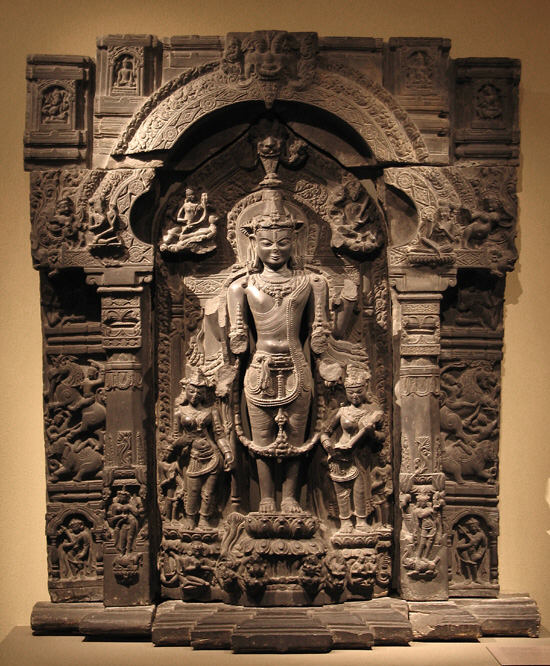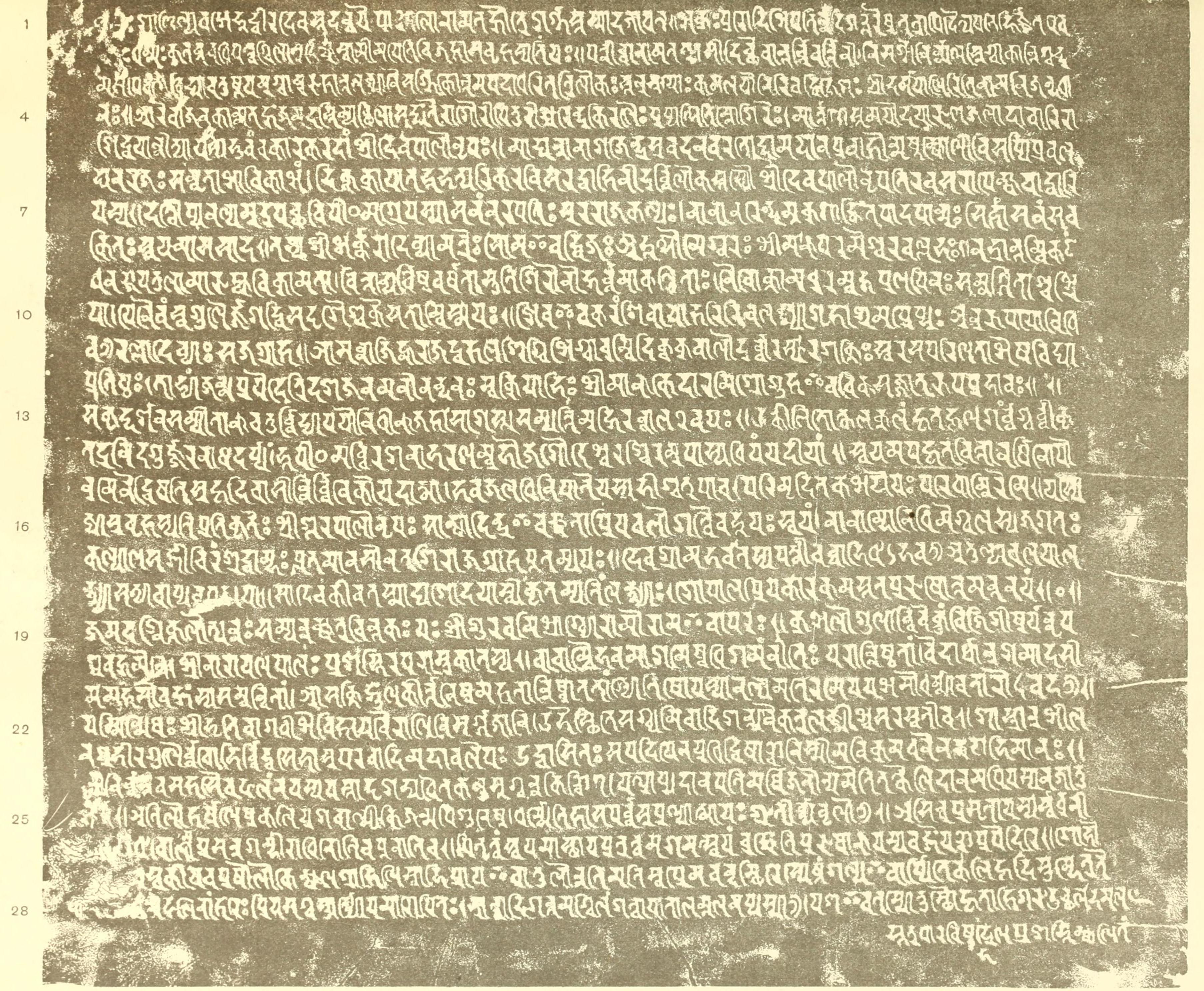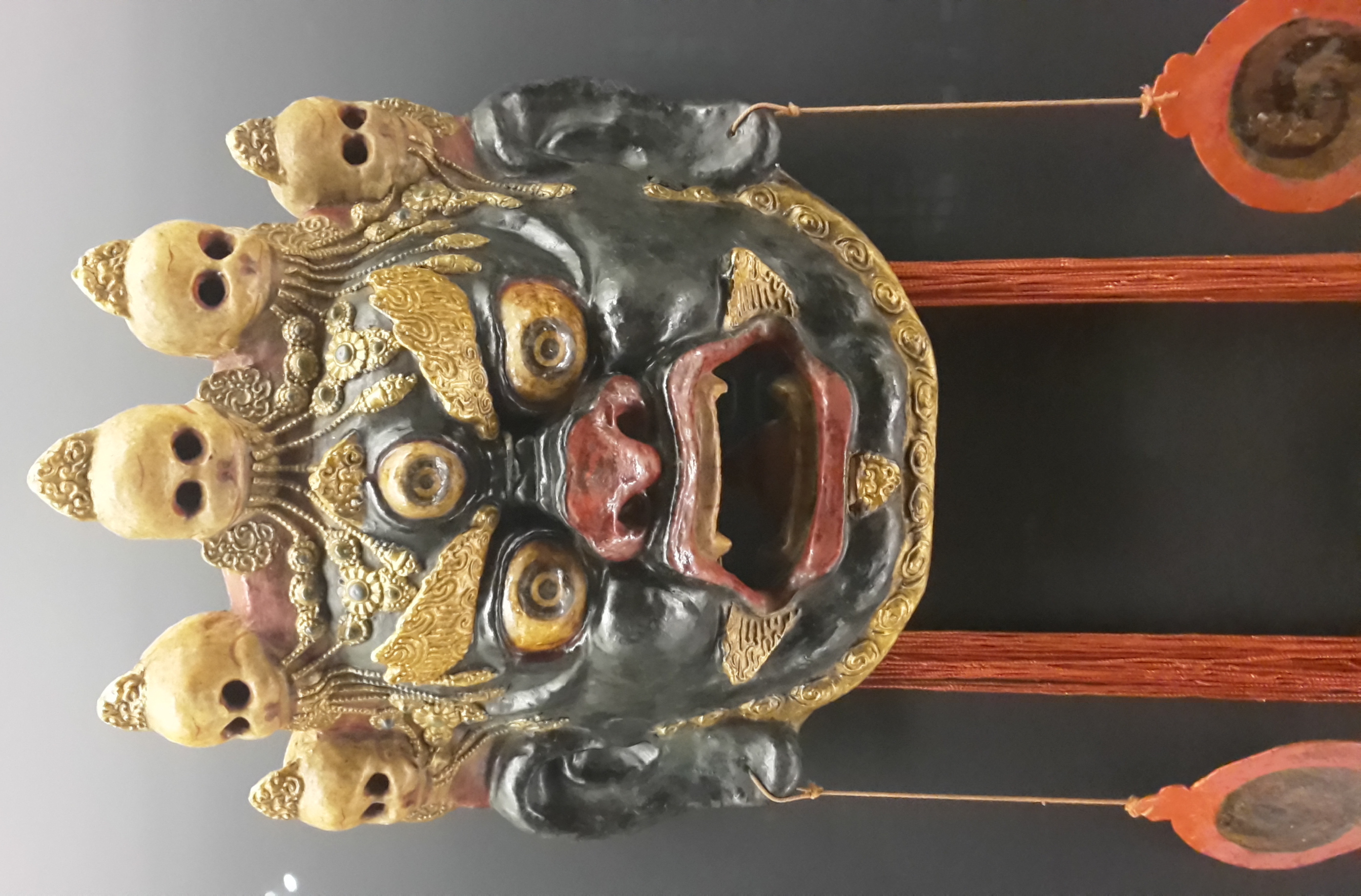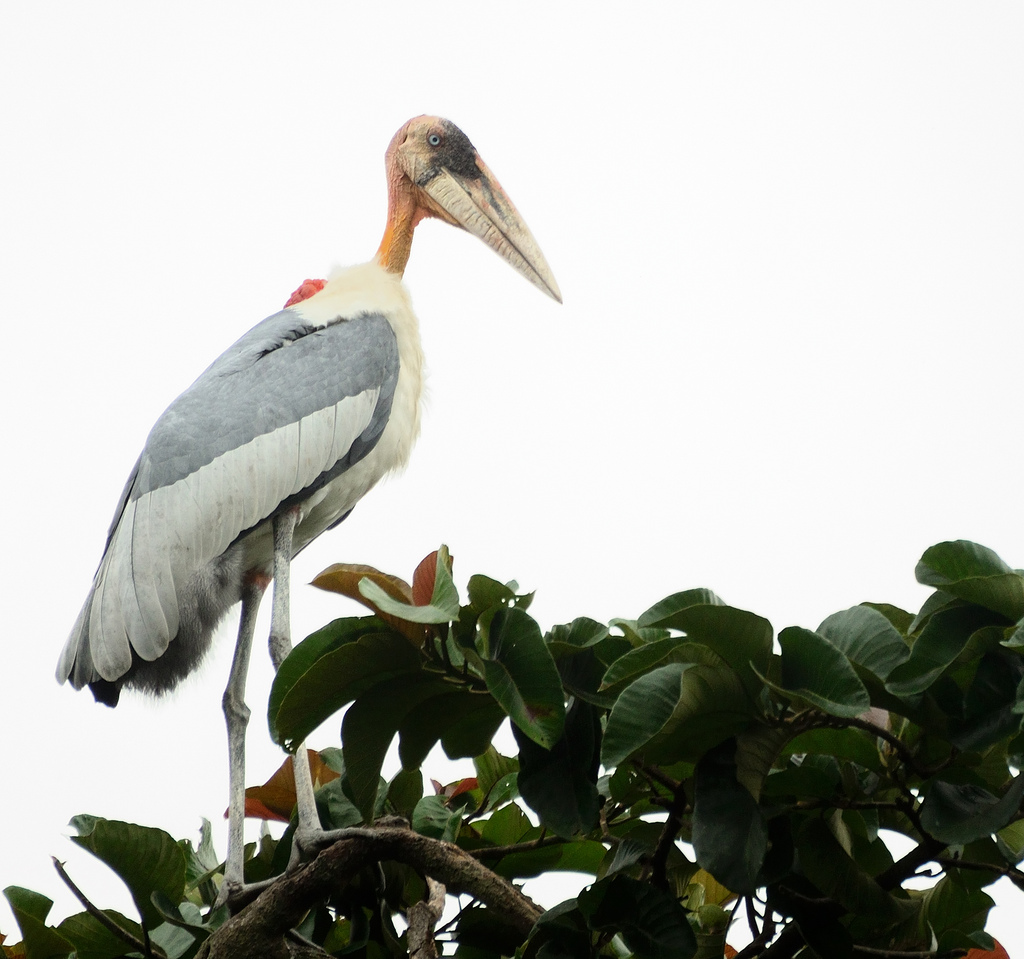|
Vigrahapala I
Vigrahapala was a 9th-century ruler of the Pala dynasty, in the Bengal region of the Indian subcontinent. He was the sixth Pala emperor. He reigned for a brief period before becoming an ascetic. Vigrahapala was a grandson of Dharmapala's younger brother Vakapala and son of Jayapala. He was succeeded by his son, Narayanapala. Ancestry Previously, the historians believed that Shurapala and Vigrahapala were the two names of the same person. However, the discovery of a copper plate in 1970 in the Mirzapur district conclusively established that these two were cousins. They either ruled simultaneously (perhaps over different territories) or in rapid succession. If they ruled in succession, it seems more likely that Shurapala preceded Vigrahapala, since Vigrahapala I and his descendants ruled in unbroken succession. Vigrahapala either dethroned Shurapala, or replaced him peacefully in absence of any direct heir to the throne. The information about him and his ancestors is found i ... [...More Info...] [...Related Items...] OR: [Wikipedia] [Google] [Baidu] |
Pala Empire
The Pāla Empire (r. 750-1161 CE) was an imperial power during the post-classical period in the Indian subcontinent, which originated in the region of Bengal. It is named after its ruling dynasty, whose rulers bore names ending with the suffix ''Pāla'' ("protector" in Prakrit). The empire was founded with the election of Gopāla as the emperor of Gauda in late eighth century AD. The Pala stronghold was located in Bengal and eastern Bihar, which included the major cities of Gauḍa, Vikramapura, Pāṭaliputra, Monghyr, Somapura, Ramavati ( Varendra), Tāmralipta and Jaggadala. The Pālas were astute diplomats and military conquerors. Their army was noted for its vast war elephant corps. Their navy performed both mercantile and defensive roles in the Bay of Bengal. At its zenith under emperors Dharmapala and Devapala in the early ninth century, the Pala empire extended their dominance into the northern Indian region, with its territory stretching across the Gangetic pl ... [...More Info...] [...Related Items...] OR: [Wikipedia] [Google] [Baidu] |
Gopala II
Gopala II (reigned after 872 CE) was the successor to the Pala king Shurapala I in the Bengal-Bihar region of the Indian subcontinent, and the sixth ruler of the Pala line reigning for at least four years. The existence of this king came to light when, in 1995, historian Gouriswar Bhattacharya discovered two copper plate inscriptions of a previously unknown Pala king in Los Angeles County Museum of Art, where these had been sent for cleaning by a private collector. This king got designated as Gopala II; consequently, existing Gopala II and Gopala III were re-designated as Gopala III and Gopala IV, respectively. The text of these two inscriptions were subsequently edited by Ryosuke Furui in 2009. Life Three copper plate inscriptions of this king have so far been discovered. One was issued in his third regnal year, the other two (the ones discovered in Los Angeles) on the same date in the fourth regnal year. As per these plates, Gopala II was the son of Shurapala I and grandson ... [...More Info...] [...Related Items...] OR: [Wikipedia] [Google] [Baidu] |
Narayanapala
Narayanapala (9th-10th century CE) was the seventh emperor of the Pala dynasty of the Eastern regions of the Indian subcontinent, mainly the Bengal and Bihar regions. He was the son of Vigrahapala I by his wife, the Kalachuri The Kalachuris (IAST: Kalacuri), also known as Kalachuris of Mahishmati, were an Indian dynasty that ruled in west-central India between 6th and 7th centuries. They are also known as the Heheya Kingdom, Haihayas or as the Early Kalachuris to d ... princess Lajjadevi. He was later succeeded by his son Rajyapala. The Gaya temple inscription dated in his 7th regnal year, the Indian Museum (found in the erstwhile Patna district) stone inscription dated in his 9th regnal year, the Bhagalpur copper-plate grant dated in his 17th regnal year, Bihar votive image inscription dated in his 54th regnal year and the Badal pillar inscription of his minister Bhatta Guravamishra provide information about his reign.Sinha, Bindeshwari Prasad (1977). ''Dynastic His ... [...More Info...] [...Related Items...] OR: [Wikipedia] [Google] [Baidu] |
Kalachuris Of Tripuri
The Kalachuris of Tripuri (IAST: ), also known the Kalachuris of Chedi, ruled parts of central India during 7th to 13th centuries. They are also known as the Later Kalachuris to distinguish them from their earlier namesakes, especially the Kalachuris of Mahishmati. Their core territory included the historical Chedi region (also known as Dahala- mandala), and their capital was located at Tripuri (present-day Tewar near Jabalpur, Madhya Pradesh). The origin of the dynasty is uncertain, although one theory connects them to the Kalachuris of Mahishmati. By the 10th century, the Kalachuris of Tripuri had consolidated their power by raiding neighbouring territories and by fighting wars with the Gurjara-Pratiharas, the Chandelas and the Paramaras. They also had matrimonial relations with the Rashtrakutas and the Chalukyas of Kalyani. In the 1030s, the Kalachuri king Gangeyadeva assumed imperial titles after achieving military successes at his eastern and northern frontiers. ... [...More Info...] [...Related Items...] OR: [Wikipedia] [Google] [Baidu] |
Bengal
Bengal ( ; bn, বাংলা/বঙ্গ, translit=Bānglā/Bôngô, ) is a geopolitical, cultural and historical region in South Asia, specifically in the eastern part of the Indian subcontinent at the apex of the Bay of Bengal, predominantly covering present-day Bangladesh and the Indian state of West Bengal. Geographically, it consists of the Ganges-Brahmaputra delta system, the largest river delta in the world and a section of the Himalayas up to Nepal and Bhutan. Dense woodlands, including hilly rainforests, cover Bengal's northern and eastern areas, while an elevated forested plateau covers its central area; the highest point is at Sandakphu. In the littoral southwest are the Sundarbans, the world's largest mangrove forest. The region has a monsoon climate, which the Bengali calendar divides into six seasons. Bengal, then known as Gangaridai, was a leading power in ancient South Asia, with extensive trade networks forming connections to as far away as Roman Egypt ... [...More Info...] [...Related Items...] OR: [Wikipedia] [Google] [Baidu] |
Indian Subcontinent
The Indian subcontinent is a physiographical region in Southern Asia. It is situated on the Indian Plate, projecting southwards into the Indian Ocean from the Himalayas. Geopolitically, it includes the countries of Bangladesh, Bhutan, India, Maldives, Nepal, Pakistan, and Sri Lanka."Indian subcontinent". '' New Oxford Dictionary of English'' () New York: Oxford University Press, 2001; p. 929: "the part of Asia south of the Himalayas which forms a peninsula extending into the Indian Ocean, between the Arabian Sea and the Bay of Bengal. Historically forming the whole territory of Greater India, the region is now divided into three countries named Bangladesh, India and Pakistan." The terms ''Indian subcontinent'' and ''South Asia'' are often used interchangeably to denote the region, although the geopolitical term of South Asia frequently includes Afghanistan, which may otherwise be classified as Central Asian.John McLeod, The history of India', page 1, Greenwood Publishing ... [...More Info...] [...Related Items...] OR: [Wikipedia] [Google] [Baidu] |
Dharmapala
A ''dharmapāla'' (, , ja, 達磨波羅, 護法善神, 護法神, 諸天善神, 諸天鬼神, 諸天善神諸大眷屬) is a type of wrathful god in Buddhism. The name means "''dharma'' protector" in Sanskrit, and the ''dharmapālas'' are also known as the Defenders of the Justice (Dharma), or the Guardians of the Law. There are two kinds of ''dharmapala'', Worldly Guardians ('' lokapala'') and Wisdom Protectors (''jnanapala''). Only Wisdom Protectors are enlightened beings. Description A protector of Buddhist dharma is called a ''dharmapala''. They are typically wrathful deities, depicted with terrifying iconography in the Mahayana and tantric traditions of Buddhism. The wrathfulness is intended to depict their willingness to defend and guard Buddhist followers from dangers and enemies. The '' Aṣṭagatyaḥ'' (the eight kinds of nonhuman beings) is one category of ''dharmapālas'', which includes the Garuda, Deva, Naga, Yaksha, Gandharva, Asura, Kinnara and Mahoraga ... [...More Info...] [...Related Items...] OR: [Wikipedia] [Google] [Baidu] |
Vigrahapala I
Vigrahapala was a 9th-century ruler of the Pala dynasty, in the Bengal region of the Indian subcontinent. He was the sixth Pala emperor. He reigned for a brief period before becoming an ascetic. Vigrahapala was a grandson of Dharmapala's younger brother Vakapala and son of Jayapala. He was succeeded by his son, Narayanapala. Ancestry Previously, the historians believed that Shurapala and Vigrahapala were the two names of the same person. However, the discovery of a copper plate in 1970 in the Mirzapur district conclusively established that these two were cousins. They either ruled simultaneously (perhaps over different territories) or in rapid succession. If they ruled in succession, it seems more likely that Shurapala preceded Vigrahapala, since Vigrahapala I and his descendants ruled in unbroken succession. Vigrahapala either dethroned Shurapala, or replaced him peacefully in absence of any direct heir to the throne. The information about him and his ancestors is found i ... [...More Info...] [...Related Items...] OR: [Wikipedia] [Google] [Baidu] |
Bhagalpur
Bhagalpur is a city in the Indian state of Bihar, situated on the southern banks of the river Ganges. It is the 2nd largest city of Bihar by population and also the headquarters of Bhagalpur district and Bhagalpur division. Known as the Silk City, it is a major educational, commercial, and political center, and listed for development under the Smart City program, a joint venture between Government and industry. The Gangetic plains surrounding the city are very fertile and the main crops include rice, wheat, maize, barley, and oilseeds. The river is home to the Gangetic dolphin, the ''National Aquatic Animal of India'', and the Vikramshila Gangetic Dolphin Sanctuary is established near the town. The city holds the largest Manasa Puja and one of the largest processions in Kali Puja, an intangible cultural heritage of the region. Demography As of the 2011 India census, the Bhagalpur Urban Agglomeration has a population of 410,210, of which 218,284 were males and 191,926 w ... [...More Info...] [...Related Items...] OR: [Wikipedia] [Google] [Baidu] |
Vigrahapala Drammas , 11th century Pala ruler of eastern India
{{hndis ...
Vigrahapala may refer to: * Vigrahapala (Chahamana dynasty), 10th century Chahamana ruler of north-western India * Vigrahapala I, 9th century Pala ruler of eastern India * Vigrahapala II, 10th century Pala ruler of eastern India * Vigrahapala III Vigrahapala III (1055 – 1070 CE) was the successor to the Pala king Nayapala in the Bengal region of the Indian subcontinent, and twelfth ruler of the Pala line reigning for 15 years. He was succeeded by Mahipala II. During the reign of Vigra ... [...More Info...] [...Related Items...] OR: [Wikipedia] [Google] [Baidu] |
Ramesh Chandra Majumdar
Ramesh Chandra Majumdar (known as R. C. Majumdar; 4 December 1888 – 11 February 1980) was a historian and professor of Indian history. Majumdar is a noted historian of modern India. He was a former Sheriff of Kolkata. Early life and education Coming from a Baidya family, Majumdar was born in Khandarpara, Gopalganj District, Bangladesh, Gopalganj, Bengal Presidency, British India (now in Bangladesh) on 4 December 1888, to Haladhara Majumdar and Bidhumukhi. In 1905, he passed his Entrance Examination from Ravenshaw College, Cuttack. In 1907, he passed F.A. with first class scholarship from Surendranath College and joined Presidency College, Calcutta. Graduating in B.A.(Honours) and M.A. from Calcutta University in 1909 and 1911, respectively, he won the Premchand Roychand scholarship from the University of Calcutta for his research work in 1913. Career Majumdar started his teaching career as a lecturer at Dhaka, Dacca Government Training College. Since 1914, he spent seven yea ... [...More Info...] [...Related Items...] OR: [Wikipedia] [Google] [Baidu] |







